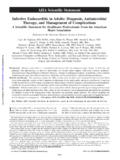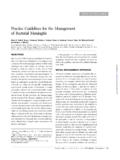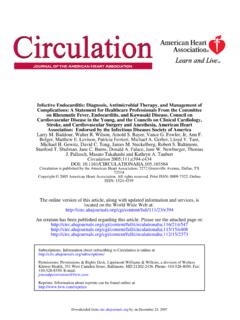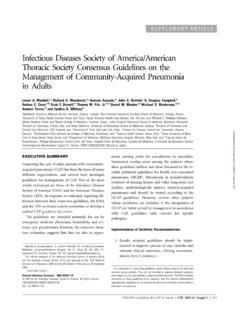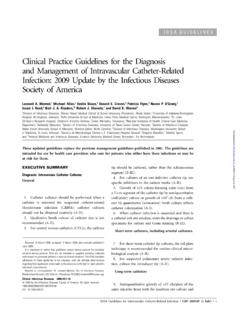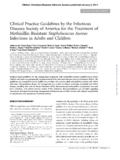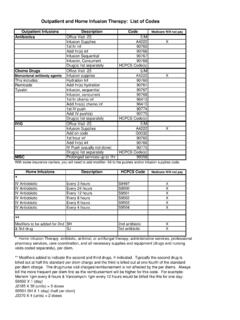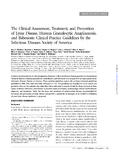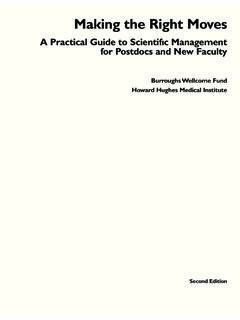Transcription of AHA Scientific Statement - idsociety.org
1 AHA Scientific Statement Infective Endocarditis in Adults: Diagnosis, Antimicrobial Therapy, and Management of Complications A Scientific Statement for Healthcare Professionals From the American Heart Association Endorsed by the Infectious Diseases Society of America Larry M. Baddour, MD, FAHA, Chair; Walter R. Wilson, MD; Arnold S. Bayer, MD;. Vance G. Fowler, Jr, MD, MHS; Imad M. Tleyjeh, MD, MSc;. Michael J. Rybak, PharmD, MPH; Bruno Barsic, MD, PhD; Peter B. Lockhart, DDS;. Michael H. Gewitz, MD, FAHA; Matthew E. Levison, MD; Ann F. Bolger, MD, FAHA;. James M. Steckelberg, MD; Robert S. Baltimore, MD; Anne M. Fink, PhD, RN;. Patrick O'Gara, MD, FAHA; Kathryn A. Taubert, PhD, FAHA; on behalf of the American Heart Association Committee on Rheumatic Fever, Endocarditis, and Kawasaki Disease of the Council on Downloaded from by guest on February 21, 2017.
2 Cardiovascular Disease in the Young, Council on Clinical Cardiology, Council on Cardiovascular Surgery and Anesthesia, and Stroke Council Background Infective endocarditis is a potentially lethal disease that has undergone major changes in both host and pathogen. The epidemiology of infective endocarditis has become more complex with today's myriad healthcare- associated factors that predispose to infection. Moreover, changes in pathogen prevalence, in particular a more common staphylococcal origin, have affected outcomes, which have not improved despite medical and surgical advances. Methods and Results This Statement updates the 2005 iteration, both of which were developed by the American Heart Association under the auspices of the Committee on Rheumatic Fever, Endocarditis, and Kawasaki Disease, Council on Cardiovascular Disease of the Young.
3 It includes an evidence-based system for diagnostic and treatment recommendations used by the American College of Cardiology and the American Heart Association for treatment recommendations. Conclusions Infective endocarditis is a complex disease, and patients with this disease generally require management by a team of physicians and allied health providers with a variety of areas of expertise. The recommendations provided in this document are intended to assist in the management of this uncommon but potentially deadly infection. The clinical variability and complexity in infective endocarditis, however, dictate that these recommendations be used to support and not supplant decisions in individual patient management.
4 (Circulation. 2015;132:1435-1486. DOI: ). Key Words: AHA Scientific Statements anti-infective agents echocardiography endocarditis infection I nfective endocarditis (IE) is an uncommon infectious dis- ease with an annual incidence ranging from 3 to 7 per 100 000 person-years in the most contemporary population 3 Although relatively rare, IE continues to be char- acterized by increased morbidity and mortality and is now the third or fourth most common life-threatening infection The American Heart Association makes every effort to avoid any actual or potential conflicts of interest that may arise as a result of an outside relationship or a personal, professional, or business interest of a member of the writing panel.
5 Specifically, all members of the writing group are required to complete and submit a Disclosure Questionnaire showing all such relationships that might be perceived as real or potential conflicts of interest. This Statement was approved by the American Heart Association Science Advisory and Coordinating Committee on May 12, 2015, and the American Heart Association Executive Committee on June 12, 2015. A copy of the document is available at by selecting either the By Topic link or the By Publication Date link. To purchase additional reprints, call 843-216-2533 or e-mail The American Heart Association requests that this document be cited as follows: Baddour LM, Wilson WR, Bayer AS, Fowler VG Jr, Tleyjeh IM, Rybak MJ, Barsic B, Lockhart PB, Gewitz MH, Levison ME, Bolger AF, Steckelberg JM, Baltimore RS, Fink AM, O'Gara P, Taubert KA; on behalf of the American Heart Association Committee on Rheumatic Fever, Endocarditis, and Kawasaki Disease of the Council on Cardiovascular Disease in the Young, Council on Clinical Cardiology, Council on Cardiovascular Surgery and Anesthesia, and Stroke Council.
6 Infective endocarditis in adults: diagnosis, antimicrobial therapy, and management of complications: a Scientific Statement for healthcare professionals from the American Heart Association. Circulation. 2015;132:1435 1486. Expert peer review of AHA Scientific Statements is conducted by the AHA Office of Science Operations. For more on AHA statements and guidelines development, visit and select the Policies and Development link. Permissions: Multiple copies, modification, alteration, enhancement, and/or distribution of this document are not permitted without the express permission of the American Heart Association. Instructions for obtaining permission are located at A link to the Copyright Permissions Request Form appears on the right side of the page.
7 (Circulation. 2015;132:1435-1486. DOI: ). 2015 American Heart Association, Inc. Circulation is available at DOI: 1435. 1436 Circulation October 13, 2015. syndrome, after sepsis, pneumonia, and intra-abdominal primarily IE in adults; a more detailed review of the unique abscess. Globally, in 2010, IE was associated with mil- features of IE in children is available in another Statement lion disability-adjusted life-years or years of healthy life lost from the AHA Committee on Rheumatic Fever, Endocarditis, as a result of death and nonfatal illness or and Kawasaki The committee also published state- Epidemiological surveys from France and the International ments on endocarditis that complicates electrophysiological Collaboration on Endocarditis have confirmed that the epide- (pacemakers, intracardiac defibrillators),21 ventricular assist, miological profile of IE has changed substantially.
8 Although and other nonvalvular cardiac the overall IE incidence has remained stable,1,2,5 9 the incidence of IE caused by Staphylococcus aureus has increased, and S Evidence-Based System for Diagnostic aureus is now the most common causative organism in most and Treatment Recommendations of the industrialized world. The emergence of S aureus IE is The writing group was charged with the task of performing an due in part to the increasing importance of healthcare contact evidence-based assessment of the data and providing a class as a leading risk associated with infection. Characteristics of of recommendation and a level of evidence for each recom- IE patients have also shifted toward an increased mean patient mendation according to the American College of Cardiology/.
9 Age, a higher proportion of prosthetic valves and other car- AHA classification system ( . diac devices, and a decreasing proportion of rheumatic heart ). The class of recommendation disease. Moreover, the proportion of IE patients undergoing is an estimate of the size of the treatment effect, considering surgery has increased over time to reach 50%.1,10,11. risks versus benefits, in addition to evidence or agreement that Downloaded from by guest on February 21, 2017. In addition to these temporal epidemiological changes, a given treatment or procedure is or is not useful or effective major new findings from multiple diagnostic, prognostic, and or in some situations may cause harm. The level of evidence therapeutic studies have been published since the last iteration of is an estimate of the certainty or precision of the treatment the American Heart Association (AHA) Statement on diagnosis effect.
10 The Writing Group reviewed and assessed the strength and management of IE complications was published in of evidence supporting each recommendation with the level of For example, the rapid detection of pathogens from valve tissue evidence ranked as A, B, or C according to the specific defini- from patients undergoing surgery for IE by polymerase chain tions included in Table 1. For certain conditions for which data reaction (PCR) has been validated. Moreover, diagnostic inno- were either unavailable or inadequate, recommendations were vations have emerged through new imaging techniques such as based on expert consensus and clinical experience, and these 3-dimensional (3D) echocardiography, head-to-toe multislice were ranked as Level of Evidence C.
